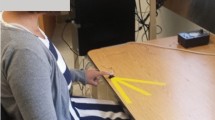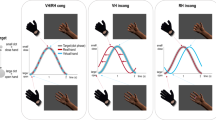Abstract
We re-examined the issue of active versus passive proprioception to more fully characterize the accuracy afforded by proprioceptive information in natural, unconstrained, movements in 3-dimensions. Subjects made pointing movements with their non-dominant arm to various locations with eyes closed. They then proprioceptively localized the tip of its index finger with a prompt pointing movement of their dominant arm, thereby bringing the two indices in apposition. Subjects performed this task with remarkable accuracy. More remarkably, the same subjects were equally accurate at localizing the index finger when the arm was passively moved and maintained in its final position by an experimenter. Two subjects were also tested with eyes open, and they were no more accurate than with eyes closed. We also found that the magnitude of the error did not depend on movement duration, which is contrary to a key observation in support of the existence of an internal forward model-based state-reconstruction scheme. Three principal conclusions derive from this study. First, in unconstrained movements, proprioceptive information provides highly accurate estimates of limb position. Second, so-called active proprioception does not provide better estimates of limb position than passive proprioception. Lastly, in the active movement condition, an internal model-based estimation of limb position should, according to that hypothesis, have occurred throughout the movement. If so, it did not lead to a better estimate of final limb position, or lower variance of the estimate, casting doubt on the necessity to invoke this hypothetical construct.





Similar content being viewed by others
References
Adamovich SV, Berkinblit MB, Fookson O, Poizner H (1998) Pointing in 3D space to remembered targets. I. Kinesthetic versus visual target presentation. J Neurophysiol 79:2833–2846
Darling WG, Miller GF (1993) Transformations between visual and kinesthetic coordinate systems in reaches to remembered object locations and orientations. Exp Brain Res 93:534–547
Fuentes CT, Bastian AJ (2010) Where is your arm? Variations in proprioception across space and tasks. J Neurophysiol 103:164–171
Gandevia SC, Smith JL, Crawford M, Proske U, Taylor JL (2006) Motor commands contribute to human position sense. J Physiol 571:703–710
Goodwin GM, McCloskey DI, Matthews PB (1972) The contribution of muscle afferents to kinaesthesia shown by vibration induced illusions of movement and by the effects of paralysing joint afferents. Brain 95:705–748
Gritsenko V, Krouchev NI, Kalaska JF (2007) Afferent input, efference copy, signal noise, and biases in perception of joint angle during active versus passive elbow movements. J Neurophysiol 98:1140–1154
Guthrie BL, Porter JD, Sparks DL (1983) Corollary discharge provides accurate eye position information to the oculomotor system. Science 221:1193–1195
Jones SA, Cressman EK, Henriques DY (2010) Proprioceptive localization of the left and right hands. Exp Brain Res 204:373–383
Matthews PB (1982) Where does Sherrington’s “muscular sense” originate? Muscles, joints, corollary discharges? Annu Rev Neurosci 5:189–218
Matthews PB (1988) Proprioceptors and their contribution to somatosensory mapping: complex messages require complex processing. Can J Physiol Pharmacol 66:430–438
McCloskey DI, Torda TA (1975) Corollary motor discharges and kinaesthesia. Brain Res 100:467–470
Monaco S, Kroliczak G, Quinlan DJ, Fattori P, Galletti C, Goodale MA, Culham JC (2010) Contribution of visual and proprioceptive information to the precision of reaching movements. Exp Brain Res 202:15–32
Paillard J, Brouchon M (1968) Active and passive movements in the calibration of position sense. In: Freedman S (ed) The neuropsychology of spatially oriented behavior. Dorsey, Homewood, pp 37–55
Soechting JF, Flanders M (1989) Errors in pointing are due to approximations in sensorimotor transformations. J Neurophysiol 62:595–608
Stevens JK (1978) The corollary discharge: is it a sense of position or a sense of space? Behav Brain Sci 1:163–165
Stevens JK, Emerson RC, Gerstein GL, Kallos T, Neufeld GR, Nichols CW, Rosenquist AC (1976) Paralysis of the awake human: visual perceptions. Vision Res 16:93–98
Wolpert DM, Ghahramani Z (2000) Computational principles of movement neuroscience. Nat Neurosci 3(Suppl):1212–1217
Wolpert DM, Kawato M (1998) Multiple paired forward and inverse models for motor control. Neural Netw 11:1317–1329
Wolpert DM, Ghahramani Z, Jordan MI (1995) An internal model for sensorimotor integration. Science 269:1880–1882
Acknowledgments
This work was funded by grants from the Canadian Institutes for health Research (CIHR) and the Canadian Foundation for Innovation (CFI) to Charles Capaday. C.C was an invited Professor of the Université Paris-Descartes. We thank Dr. Mel Goldfinger and Prof. John Van Opstal for their comments and suggestions on a draft of the manuscript.
Author information
Authors and Affiliations
Corresponding author
Rights and permissions
About this article
Cite this article
Capaday, C., Darling, W.G., Stanek, K. et al. Pointing to oneself: active versus passive proprioception revisited and implications for internal models of motor system function. Exp Brain Res 229, 171–180 (2013). https://doi.org/10.1007/s00221-013-3603-4
Received:
Accepted:
Published:
Issue Date:
DOI: https://doi.org/10.1007/s00221-013-3603-4




